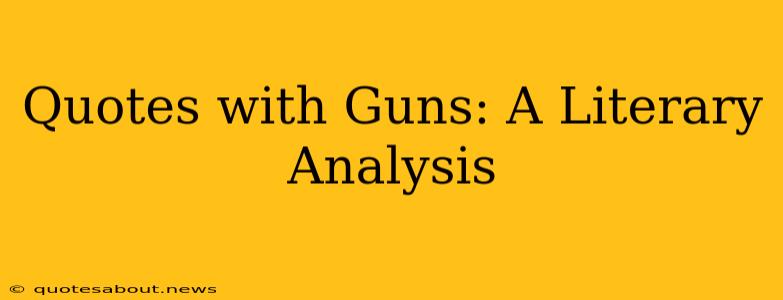Guns, potent symbols of power, violence, and societal anxieties, frequently feature in literature, transcending mere plot devices to become profound metaphors. This exploration delves into the multifaceted role of guns in literary works, examining how authors utilize them to explore themes of power dynamics, morality, and the human condition. We will analyze how the presence of a gun, even without being fired, can drastically alter the narrative landscape and character development.
Why are Guns so Prevalent in Literature?
Guns hold a unique position in literary narratives because they represent a potent confluence of several compelling themes. They symbolize:
-
Power and Control: The possession of a firearm often signifies dominance, control over oneself and others, and the ability to inflict harm or enforce one's will. A gun can empower a character, providing a sense of security or enabling them to overcome obstacles. Conversely, the lack of a gun can highlight vulnerability and powerlessness.
-
Violence and Death: The most obvious function of a gun in literature is its capacity for violence and death. This aspect can be used to explore themes of conflict, trauma, revenge, and the consequences of violent actions. Authors can use gun violence to heighten dramatic tension, create suspense, or expose the brutal realities of conflict.
-
Social Commentary: Guns are frequently used as a tool for social commentary. Their presence can reflect societal anxieties about violence, gun control, and the potential for societal collapse. Authors might use guns to criticize existing power structures or explore the impact of political and social unrest.
-
Internal Conflict and Moral Dilemmas: Even the mere presence of a gun can create significant internal conflict for a character. The decision to use it, or not to use it, can force characters to confront their own morality, beliefs, and the potential consequences of their actions. This internal struggle often forms the core of compelling literary narratives.
How Do Authors Use Guns as Literary Devices?
Authors employ various techniques to integrate guns into their narratives effectively:
-
Symbolism: Guns can represent far more than just weapons; they can symbolize masculinity, freedom, rebellion, or even death itself. The symbolic weight of a gun often surpasses its practical function.
-
Foreshadowing: The introduction of a gun early in a story can foreshadow future violence or conflict, creating suspense and anticipation for the reader.
-
Character Development: A character's interaction with a gun can reveal significant aspects of their personality, motivations, and moral compass. Their handling of a weapon, their attitude towards it, and their decisions regarding its use can all contribute to a more complex and nuanced portrayal of the character.
What are Common Themes Explored Through Guns in Literature?
Several recurring themes emerge from literary works featuring guns:
-
The Burden of Responsibility: Characters who possess guns often grapple with the weight of responsibility that comes with wielding such a powerful instrument. The potential for harm and the consequences of their actions can weigh heavily on their minds.
-
The Nature of Violence: The presence of guns often forces a confrontation with the nature of violence, its causes, its consequences, and its potential to escalate conflicts.
-
Justice and Revenge: Guns frequently play a role in narratives concerning justice, revenge, and the pursuit of retribution. Authors explore the ethical implications of seeking justice through violence and the potential for unintended consequences.
-
Loss and Trauma: Gun violence often leads to loss and trauma, leaving lasting scars on characters and communities. Authors use these experiences to explore the emotional and psychological impact of violence.
What are Some Examples of Literary Works Featuring Guns Prominently?
While providing specific examples requires careful consideration of copyright and avoiding direct links, it's worth noting that countless literary works across various genres effectively utilize the symbolism and impact of guns. Consider exploring works known for their impactful depictions of violence, social commentary, or character-driven narratives. Look for examples in classic and contemporary literature to understand the evolution and ongoing relevance of this potent literary device.
By understanding the symbolic power, thematic implications, and literary techniques associated with guns in literature, we can gain a deeper appreciation for how authors use this powerful symbol to explore the complexities of the human condition. The gun, more than just a weapon, becomes a lens through which we can examine themes of power, violence, morality, and the lasting impact of human actions.

